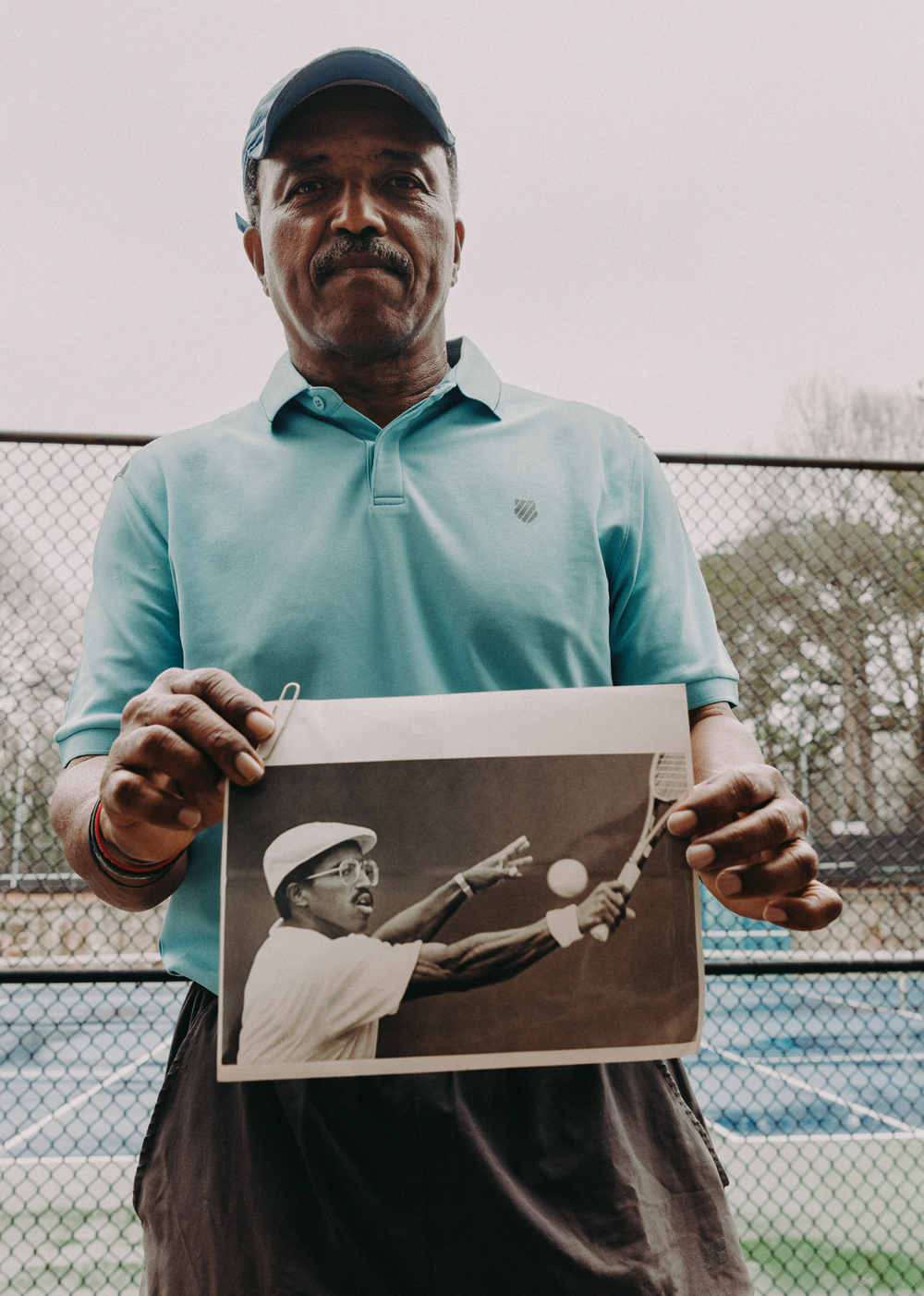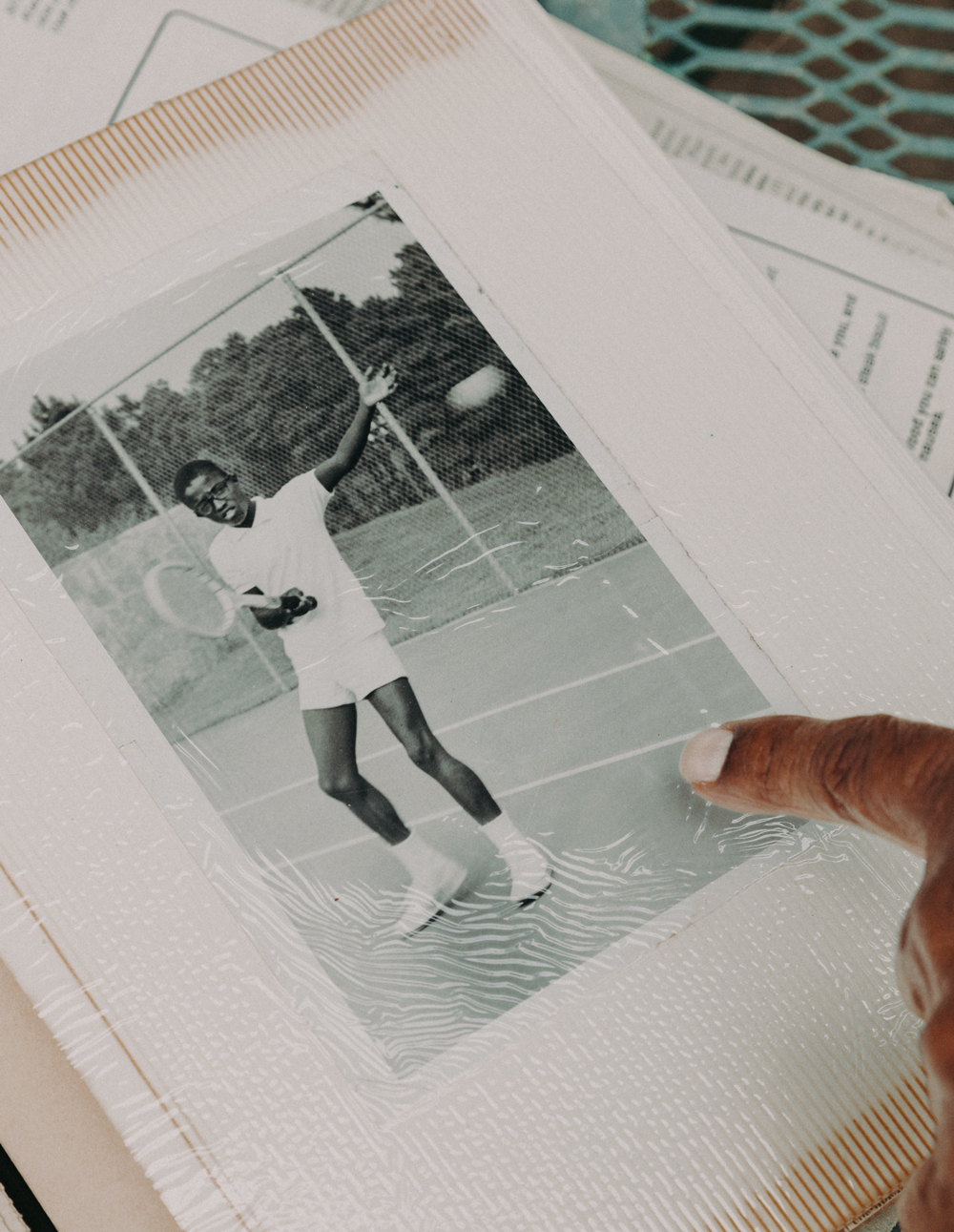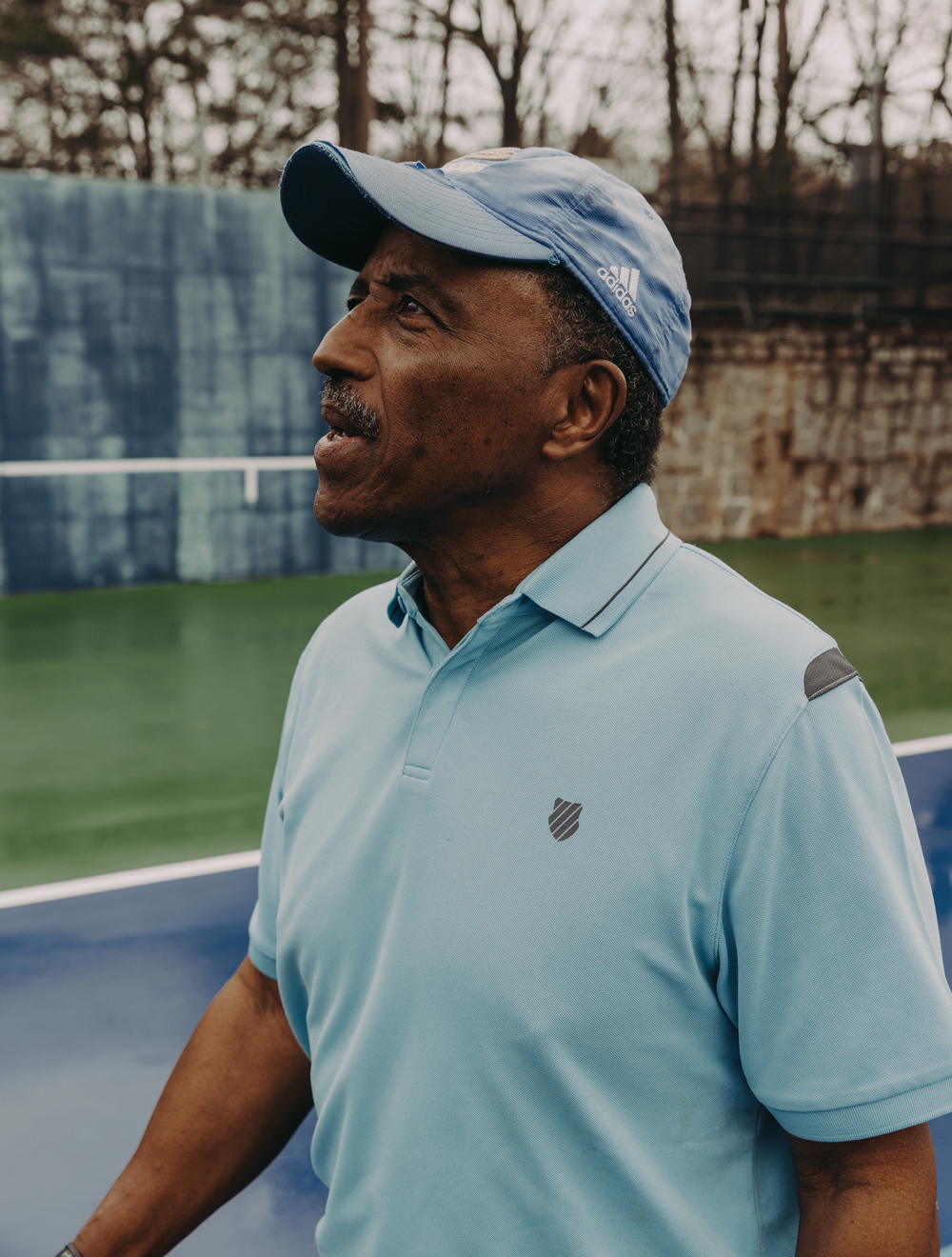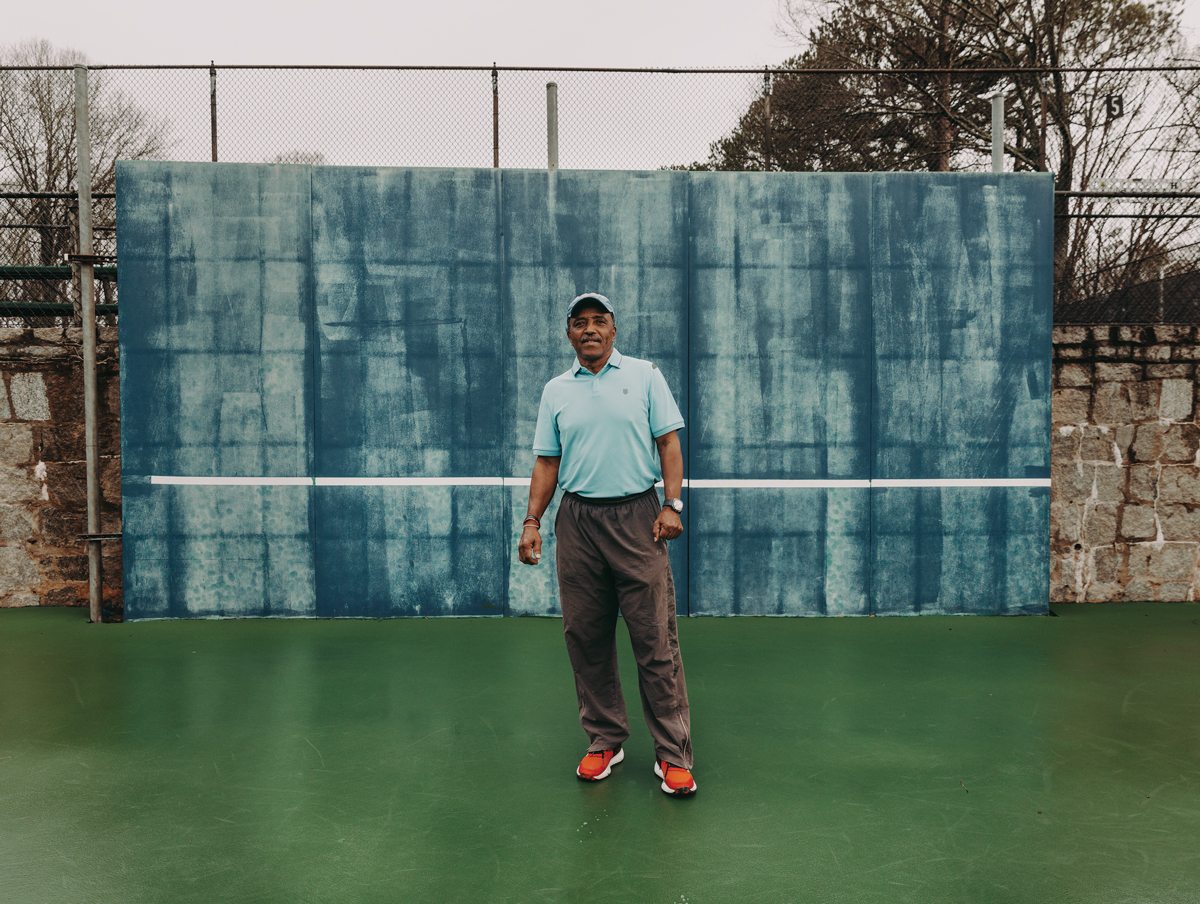
Photograph by Growl Bros.
The kid is clearly exhausted. Facing a fourth match point in the 1972 American Tennis Association (ATA) National Championships final against Arthur Carrington, a man several years his senior, the kid—Atlantan Horace Reid—can’t hide his fatigue. It’s hard to blame him: The physical toll of this four-hour match has been compounded by cramps and a torn rotator cuff.
Reid, a rising tennis star, cuts an eccentric figure: baby-faced with a short bowling ball of an Afro, mismatched socks, a cuff of rubber bands on either wrist, and a neckband stretched halfway down his torso. Barely 17, Reid looks more as if he’s late for homeroom than about to fend off another match point in a fifth-set tiebreaker. He does all he can to slow his heaving chest, to save his thick-rimmed glasses from slipping down the sweat-slicked slope of his nose.
The ATA is the country’s oldest African American tennis organization, and this year’s championship is the first to be televised. With a title on the line, Reid needs to win the next two points—which he precisely does. First, he drops a lob over his opponent’s head, and then, for match point, he smashes two forehands that send Carrington scrambling from end to end. “He goes for it!” Bud Collins, the legendary tennis announcer, gasps on TV, working the broadcast alongside Althea Gibson, a pioneering Black tennis champion. The commentators can barely believe what they’re seeing.
It was an improbable win—and one hell of a comeback—for Reid. But for those who knew him, the victory might have seemed inevitable: just the latest entry in the storybook rise of a late-to-the-game prodigy who, at 12, became the first Black player to win a Georgia State Junior Open title (in his first-ever USTA tournament, no less); was ranked top 10 in the nation by 14; and so thoroughly dominated his high school competition he felt the need to leave the state entirely.
It wasn’t unreasonable to imagine Reid on a rocket ship to the top of the tennis world. Many already saw him as the next great Black champion—a comparison Arthur Ashe seemed to endorse when he offered his support to Reid. But within a few years, Reid’s tennis dreams would be all but dashed: He’d quit college, fail to find consistency on the pro tour, and suffer an agonizing fallout with Ashe, his hero and would-be mentor. The rupture would not only hamstring Reid’s career, in his telling, but also burden him with a secret he felt he could never share: how everything went so wrong.
● ● ●
The whole thing started innocently enough—or maybe not. It was 1964, the summer Horace Reid turned nine, and the kid wanted to steal a tennis ball. There were just so many of them scattered on the other side of a high fence that separated Washington Park’s new tennis center from the neighborhood. But before Reid could begin his career of petty larceny, he heard a loud voice calling to him. “Hey, young man!”
The voice belonged to Branch Curington, a tennis pro who ran the center and would emerge as perhaps the most influential figure in Atlanta’s growing Black tennis community. On this day, Curington instructed Reid to help him pick up balls, offering an ice cream cone as a reward. The next day, Reid returned. But instead of ice cream, Curington handed him a racket.
For Reid, who was raised by a single mother, Curington represented more than a coach. “He became a father figure to me. My whole personality is based off of him,” says Reid, who sponged the fundamentals of tennis (and life) at Washington Park.

Photograph by Growl Bros.
The game came almost effortlessly. When Reid won the 1967 Georgia State Junior Open, held at Bitsy Grant Tennis Center, he did so as an unseeded entrant, becoming a citywide sensation. He began competing on the junior circuit and shot up the rankings, as his local celebrity morphed into national acclaim. Tennis’s chattering class anointed him “the next Arthur Ashe.”
Billy Martin, the current UCLA men’s tennis coach, remembers Reid’s game vividly. “Biggest forehand ever,” he says. “It was just an awesome shot.” Reid had an aggressive style that could “dominate the court,” per Martin, who also served as his doubles partner. (Together they won the 16-and-under National Clay Court Doubles Championship and made it to the finals of the Junior Orange Bowl.)
In a city rife with racial tensions, the effect of Reid’s successes could be seen almost overnight. Suddenly, droves of White kids were showing up at Washington Park, hoping to catch whatever magic dust Curington was sprinkling, while others invited Reid to play at old-money country clubs in north Atlanta.
For his part, Reid didn’t reflect too deeply on the meaning of being a Black star in a traditionally White sport. Which isn’t to say he had it easy. Racism stalked his travels across the South, while some within the Black community antagonized him too. Tennis was seen not just as a White game, but also as a “sissy” sport, and he was frequently derided as “a tennis bum” and “a faggot.”
“Horace has an important place in tennis for what he was able to achieve. He really was a pioneer, and he’s considered one of the legends of Bitsy Grant.”
— Richard Howell
Through it all, Reid maintained his confidence and independence. “That’s the Branch in me,” he says. His self-determination fueled his quirky fashion choices as well as his departure from Georgia after winning multiple state titles; high school rules prohibited him from playing in national competitions. It also led him to an early exit from the Port Washington Tennis Academy on Long Island, where he went to train under Harry Hopman, the renowned Australian Davis Cup coach, alongside players like John McEnroe and Vitas Gerulaitis. There, he clashed with Hopman, who favored intense conditioning over the technical development Reid still needed.
The breaking point came in the summer before his senior year, when Reid, fed up with Hopman, contacted Ashe. He’d met the champ once before, as an 11-year-old, and had idolized him ever since. Now Reid hoped his hero might thumb the scales on his behalf. Ashe drove to Long Island and brought Reid to Manhattan. As they wove through the city streets, Reid explained his situation: his desire for personalized coaching; his need for sponsorship money; and his dream of attending UCLA, Ashe’s alma mater.
When Ashe agreed to help, even offering use of his apartment, Reid could hardly believe it. “My feet are not even touching the ground at that point,” he recalls. “I got my hero mentoring me, sponsoring me . . . I got it made. There’s nothing that’s not going to be available to me.”
Reid remembers thinking, How can I not succeed?
● ● ●
There were early signs that Reid’s relationship with Ashe wasn’t all it had seemed—or all he’d built it up to be in his mind.
For starters, before his first tournament under Ashe’s patronage, Reid got stuck holding the bill after his luggage got lost in transit, despite Ashe’s promise to pay. “He said, ‘Don’t worry. Just keep the receipts,’” says Reid. But the reimbursement never came, and Reid was too timid to ask for the cash. There was also a lengthy letter Reid received that concluded with a list of eight reasons Ashe had decided to help. Reid found the list “strange” on its face, “but the thing that stood out was the eighth reason: because I was Black,” he says. “You’re telling me, in this era, me being Black is the last reason—the least important reason—for you to help me? I found that really weird.”

Photograph by Growl Bros.
Still, when Reid arrived at UCLA—where Ashe made good on his word to get him in and even paid for part of his scholarship—things were looking up. On the court, Reid played singles and doubles for one of the country’s top teams. Off the court, he hobnobbed with Hollywood royalty, teaching tennis to A-listers like Gene Hackman and eating Thanksgiving dinner with Marlon Brando. So you can imagine Reid’s surprise when, in a phone call before his sophomore year, Ashe suggested he transfer to a Division II school.
Reid wasn’t just blindsided; he felt betrayed. “It didn’t make any sense to me,” says Reid, who suspects Ashe was acting as a proxy for UCLA’s coach, Glenn Bassett, who he believes wanted his roster spot. “This was strictly him doing his buddy a favor, which hurt.” Questioning whether Ashe had his best interests at heart, Reid refused to transfer. “And, boy, he was not expecting me to say that, and things just went totally south.”
Ostensibly, their arrangement remained unchanged, but Reid sensed a newfound coldness from Ashe, who’d always been standoffish. Previously, sponsorship checks would arrive from around the world with regularity—if not with words of encouragement. Now, the mail stopped coming. Reid was forced to borrow money; he says Ashe promised he’d pay him back but never did. “It was so embarrassing,” says Reid. “He would say something and then wouldn’t do it. He was basically sending me a message. Like, ‘Hey, I’m done with you.’ But why wouldn’t he just say that to my face?”
The uncertainty took a toll. “I got so depressed that I stopped going to class,” he says. “He made me feel like I was a bad guy.” When J.D. McGhee, one of Reid’s earliest supporters, died in the summer of 1975, Reid flew home for the funeral—and never returned. “I just dropped out of school,” he says. “I didn’t know what I was going to do.”
● ● ●
In hindsight, Reid concedes he should have transferred to another program. “I still had eligibility,” he says. “I could have gone to any top 10 school.” Instead, reeling from his split with Ashe, he ditched the idea of further collegiate development and set out on the pro tour. It proved an uneven effort.
Despite his natural talent and flashes of brilliance, including a notable doubles run at the 1979 U.S. Open, Reid struggled to find his footing, peaking at 272 in the ATP singles rankings and 227 in doubles. His game could have used more seasoning, but Reid’s years on the circuit were also plagued by unreliable funding, leading to frequent stretches of inactivity.
The narrative of Reid’s career shifted from that of a can’t-miss wunderkind to a once-promising player who’d hit his ceiling. For Reid, this was a lonely time, not least because he felt he couldn’t tell his side of the story. “That’s what killed me,” he says. “I had to bite my lip. I couldn’t say anything, because whose word are you going to take? This guy is a tennis god. I’m a nobody.”
In 1982, by which time Reid had effectively given up, a reporter from the Atlanta Constitution convinced the then 27-year-old to go on record about his break with Ashe. The resulting article painted an unflattering picture of Reid as a player who just wasn’t good enough. Both Ashe and Bassett claimed Reid couldn’t hack it on a UCLA team that featured players like future champion Brian Teacher and Reid’s old pal Billy Martin. (Martin, who appreciates the difficult roster decisions every coach must make, nonetheless takes exception to this suggestion. He says, “He did make it there! He was on the team, and his level was very high.”) Worst of all was a line from Ashe denying he’d ever agreed to mentor Reid. Said Ashe, “I’ve never had what you might call a protege. I’ve never taken someone in.”
Reading that, Reid felt gaslit. “It still burns,” he says. “And it just pisses me off even more that the guy would sit there and bald-faced lie that he never took on that responsibility. Never had a protege? What do you call spending your money on me? What do you call offering me your apartment?”
Whatever transpired between the two athletes, there’s no question that Reid’s fractured relationship with Ashe paled in comparison to what he felt had been promised—and that disconnect has come to define, in Reid’s mind, the collapse of his athletic career over the many decades since.
● ● ●

Photograph by Growl Bros.
Today, Horace Reid works as the tennis director for a community organization in Camilla, about three hours south of Atlanta, where he often feels forgotten. The kids to whom he gives lessons know little about his backstory. It’s true: His name doesn’t ring out across the state as it once did. But according to Richard Howell, who chairs the selection committee for the Georgia Tennis Hall of Fame, nothing should take away from Reid’s legacy.
“Most young kids don’t even know who Wilt Chamberlain is,” says Howell, whose family helped Reid enter that first USTA tournament in 1967. “Horace has an important place in tennis for what he was able to achieve. He really was a pioneer, and he’s considered one of the legends of Bitsy Grant.”
In 1997, Reid was inducted into the Georgia Tennis Hall of Fame. But even that honor couldn’t close the book on his past. There had been a point, in the early ’90s, when Reid, desperate for closure, resolved to confront Ashe. But he never got the chance. “I remember I was in my car driving,” he says, “and on the news comes, ‘Arthur Ashe has died.’” Reid was stunned, and angry. He debated going to the funeral but couldn’t bring himself to do it. “I couldn’t sit there and mourn this guy when I hated him,” he says. “I literally hated him.”
Now 69, Reid believes there may still be a way to find peace: by taking a kid under his wing, just as Branch Curington did for him. It almost makes too much sense as a final chapter—to become the next Curington, the anti-Ashe—assuming he can locate such a youngster. “I haven’t found [that] one kid that wants to eat, sleep, and drink tennis like I did,” says Reid. “That’s literally all I want to do. Find a kid that wants to be great, and give them all the help that I got.”
And all the help he never did.
This article appears in our April 2025 issue.
Advertisement




